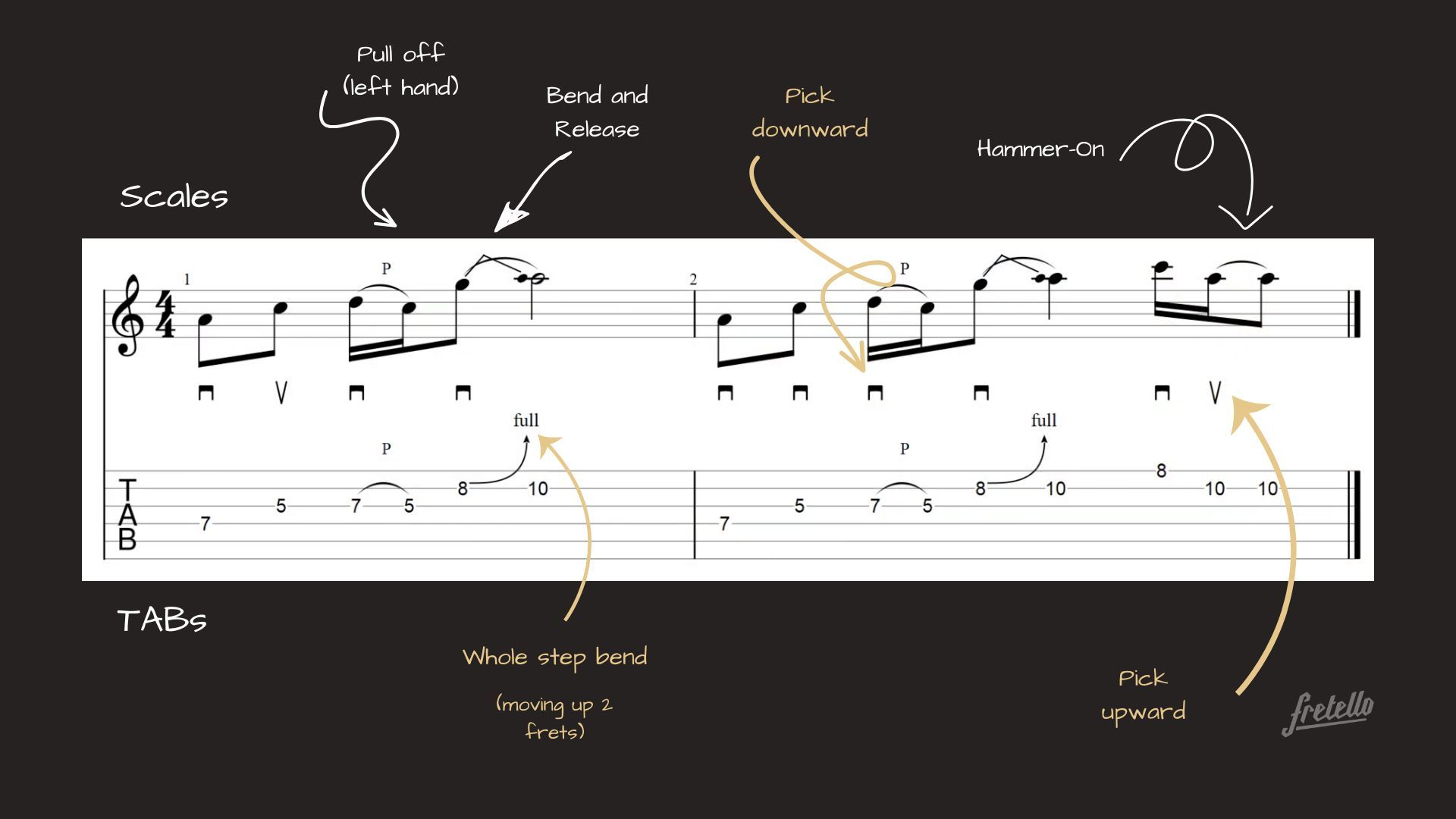Guitarists have been using tabs for decades as a practical way to share and learn songs before formal music notation was widely accessible for guitar. Tabs are beneficial because they show exact finger positions and techniques without needing to read standard notation, making it easier and faster for many players to pick up their favorite riffs and melodies.
What is a Chord Chart?
A chord chart (or chord diagram) shows you how to play a specific chord on the guitar. It’s like a map of the fretboard that tells you where to place your fingers.

How to Read a Chord Chart:
- Vertical lines represent the strings of the guitar (low E on the left, high e on the right).
- Horizontal lines represent the frets.
- Dots show you where to place your fingers.
Numbers below or beside the dots tell you which finger to use:
- 1 = index
- 2 = middle
- 3 = ring
- 4 = pinky
- O above a string means play it open (no finger pressing).
- X above a string means do not play it.
Example: Open C Major Chord

You can also find it in a written form like that:
e|---0---| (play open)
B|---1---| (index finger, 1st fret)
G|---0---| (play open)
D|---2---| (middle finger, 2nd fret)
A|---3---| (ring finger, 3rd fret)
E|---X---| (don’t play)Both ways show you exactly how to position your fingers and which strings to strum, while playing the chord.
What is Guitar Tab (Tablature)?
Guitar tablature, or tab, is a system of notation that shows you exactly where to put your fingers to play melodies, riffs, or chords.

How to Read Guitar Tab:
- Six horizontal lines represent the six strings (top line = high e, bottom line = low E).
Numbers on the lines tell you which fret to play:
- 0 = open string
- 1 = first fret
- 2 = second fret, and so on.
Example: Simple Melody
e|-----0-1-0---|
B|---1-------1-|
G|-------------|
D|-------------|
A|-------------|
E|-------------|This shows:
- Play the open high e string.
- Then 1st fret on the high e string.
- Back to open.
- Then 1st fret on the B string.
- Back to open high e.
Special Symbols in Tabs
Tabs also include symbols for playing techniques:
- h = hammer-on
- p = pull-off
- b = bend
- r = release bend
- */ or * = slide up or down
- ~ = vibrato
Example: Pull-Off and Hammer-On
e|---0h1p0---|- Play the open string, hammer-on to the 1st fret, then pull-off back to open.
Reading Rhythm in Tabs
Most tabs don’t show rhythm directly. Instead, you need to listen to the song or find sheet music to understand how long to hold each note. Some advanced tabs may use:
- Stems and flags (like sheet music)
- Spacing (notes further apart are played later)
Putting it All Together: Chords and Tabs
Many guitar resources show both chord charts and tabs together. For example:
- Chord chart for the chord shape.
- Tab for fingerpicking or a riff.
Example: Picking Pattern for C Major Chord
e|---------0-|
B|-------1---|
G|-----0-----|
D|---2-------|
A|-3---------|
E|-----------|Here, you see a tab that outlines a picking pattern using the open C chord shape.
Tips for Learning with Chord Charts and Tabs
- Start Slowly: Practice placing your fingers one at a time.
- Use a Metronome: Helps with timing if the tab doesn’t show rhythm.
- Listen to Recordings: Tabs alone don’t show rhythm, so your ear is key.
- Practice Regularly: Reading charts and tabs gets easier the more you use them.
- Focus on Clean Notes: Don’t rush—make sure each note rings clearly.
Conclusion
Being able to read chord charts and tabs will supercharge your learning and playing. They’re the foundation of how most guitarists learn songs, from simple strumming to complex solos.
Ready to Learn More?
At Fretello, we’re passionate about helping you become the guitarist you want to be. Our step-by-step lessons, masterclasses, and interactive tools make learning chords and tabs easier than ever. Start for free and see how quickly your playing can improve!